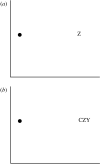Reverse hierarchies and sensory learning
- PMID: 18986968
- PMCID: PMC2674477
- DOI: 10.1098/rstb.2008.0253
Reverse hierarchies and sensory learning
Abstract
Revealing the relationships between perceptual representations in the brain and mechanisms of adult perceptual learning is of great importance, potentially leading to significantly improved training techniques both for improving skills in the general population and for ameliorating deficits in special populations. In this review, we summarize the essentials of reverse hierarchy theory for perceptual learning in the visual and auditory modalities and describe the theory's implications for designing improved training procedures, for a variety of goals and populations.
Figures






References
-
- Adini Y., Sagi D., Tsodyks M. Context-enabled learning in the human visual system. Nature. 2002;415:790–793. - PubMed
-
- Adini Y., Wilkonsky A., Haspel R., Tsodyks M., Sagi D. Perceptual learning in contrast discrimination: the effect of contrast uncertainty. J. Vis. 2004;4:993–1005. doi:10.1167/4.12.2 - DOI - PubMed
-
- Afraz S.R., Kiani R., Esteky H. Microstimulation of inferotemporal cortex influences face categorization. Nature. 2006;442:692–695. doi:10.1038/nature04982 - DOI - PubMed
-
- Ahissar M. Dyslexia and the anchoring-deficit hypothesis. Trends Cogn. Sci. 2007;11:458–465. - PubMed
-
- Ahissar E., Ahissar M. Plasticity in auditory cortical circuitry. Curr. Opin. Neurobiol. 1994;4:580–587. doi:10.1016/0959-4388(94)90060-4 - DOI - PubMed
Publication types
MeSH terms
Grants and funding
LinkOut - more resources
Full Text Sources
